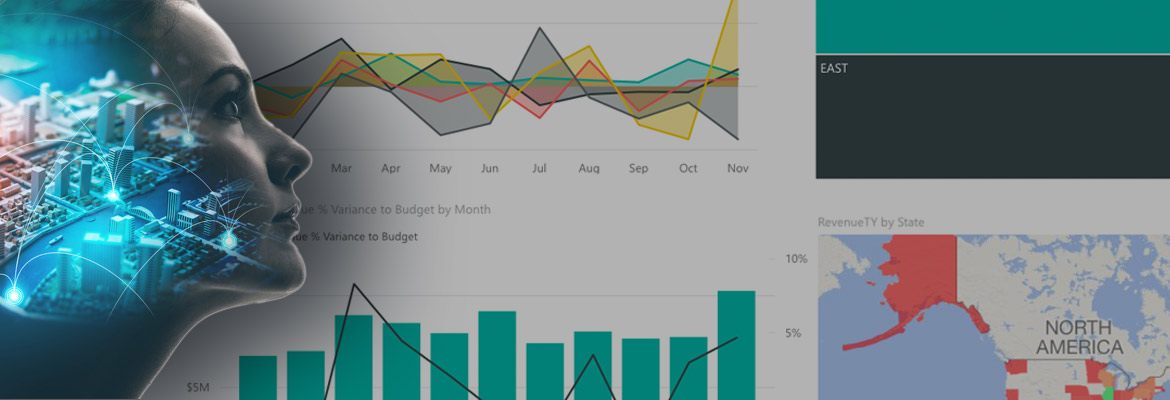AI vs. BI for Business, What Do You Need?

With all the attention being paid to artificial intelligence (AI) these days, it’s no surprise that enterprise leaders are scrambling to find ways to shoehorn AI implementations into their technology stack. But when you ask leaders in the enterprise to define what they’re looking for from AI, their answers frequently focus on solutions that will empower better business decision making.
But are those tools powered by artificial intelligence? AI, colloquially, is used to refer to a number of computer-powered business decision drivers, including automation (not AI), data modeling (not AI), and reporting and analytics (also not AI). And while artificial intelligence has the potential to augment each of those areas, they aren’t areas of focus specifically tied to AI; rather, each of these areas is actually addressed by a different class of ‘intelligence’ software—specifically, business intelligence (or BI).
So why the confusion? Despite being half a century old, the practical applications for artificial intelligence are still misunderstood by business leaders—but that isn’t stopping businesses from boarding the hype train in pursuit of unrealized benefits and profits. Bloomberg economist Michael McDonough has tracked companies mentioning ‘artificial intelligence’ on earnings calls since 2008 and has found that while the number of mentions has ballooned, the actual applications have not1. So what can AI actually do?
Natural language processing (NLP): Natural language processing is focused on improving communication between humans and machines, by analyzing human language inputs (either via direct messages, online comments, or searches) and providing outputs (either analysis or generating a response.) Think of voice assistants like Microsoft Cortana or Siri, or the voice technology underpinning voice-controlled devices like Amazon Alexa or Google Home—these services use NLP to analyze, parse, and react contextually to voice cues.
Vision systems: Vision systems are capable of analyzing and interpreting visual images, such as aerial photographs, medical imaging, or product labels. Facebook’s facial recognition photo tagging is an example of a vision system.
Machine learning: Machine learning, at its core, is the process of getting computers to learn and act like humans by responding to variable data inputs. Rather than explicitly programming computers to provide a specific answer, algorithms are applied to layers of data that map variable inputs to variable outputs and gives the computer the opportunity to learn progressively each time they execute a task.
AI planning and scheduling: The planning and scheduling branch of artificial intelligence primarily applies to autonomous machines such as industrial machinery, autonomous cars, or robots. To successfully interact with the physical world, these devices must be able to observe the world through different types of sensors and perform actions based on those observations.
In each of these applications, the differentiator is that machines aren’t simply reacting to data and providing a prescriptive output. They’re continually learning, iterating, and adapting to new data inputs. But before you take on the enormous expense and overhead of AI configuration and deployment, you need to ask yourself—is this really what you’re looking for?
The ultimate objective of artificial intelligence is to create computers that can simulate human thought—which is a noble objective, to be sure, but less valuable to an enterprise than a school of technology specifically devoted to helping businesses analyze performance, understand the past, and predict the future. Business intelligence, by definition, “includes the applications, infrastructure and tools, and best practices that enable access to and analysis of information to improve and optimize decisions and performance” in a business environment.
What are some of the core components of business intelligence? Beyond data warehousing and OLAP cubes, which provide the technical foundation, there are a number of additional components that can help enterprise businesses address their data requirements:
Data modeling: Data modeling is a method of mapping out individual data sources across an enterprise and determining how they need to interact with one another to extract the most valuable business insights. Data modeling can be performed at the conceptual (high-level, related to business objectives), logical (mapping to each business function), and physical (how the actual dimensions, measures, and hierarchies are related within a data cube).
Analytics and reporting: Capturing, structuring, and storing data is good—but being able to analyze and report on it is the ultimate end goal. Business intelligence solutions are capable of providing simple, accessible analytics and reporting functions for end users, empowering them to find the actionable insights they need with little technical expertise (or formal data science training.) This also helps business functions avoid unnecessary data logjams and gives instant access to the data they so desperately require.
Data visualization and dashboards: Analytics and reports are a crucial component of business intelligence, but if you’ve ever spent hours poring over a table of values trying to decipher exactly what the data is saying, you’re not alone. With data visualization tools, critical insights are displayed in rich graphical representations that are easier for the human brain to interpret. According to a study by Aberdeen Group, organizations using data visualization tools are 28 percent more likely to find timely information than those who rely solely on managed reporting; the same study also found that 48 percent of business intelligence users at companies with visual data discovery are able to find the information they need without the help of IT staff. Dashboards can easily assemble visualizations and reports into customizable displays by end-user or business unit, giving individuals instant insight into KPIs that help drive better business performance from the bottom up.
Security, simplicity, speed—these are the three major benefits business intelligence solutions help to drive, and three critical measures of success in enterprise business. While artificial intelligence remains focused on helping computers glean insight entirely on their own, business intelligence is enabling entire organizations to gain access to the data they need to make rapid, informed decisions, and the importance of that in today’s quickly shifting business landscape simply can’t be overstated. In a survey2 of 2,600 business intelligence end users, 91% responded that BI gave them faster reporting, analysis or planning; 84% said it enabled them to make better business decisions, and 79% said it improved employee satisfaction.
AI will undoubtedly have a dramatic impact on businesses in the coming years, but don’t mistake the benefits being offered by BI today for advanced algorithms or thinking computers. By investing in BI, businesses will be able to better prepare themselves for the era of self-taught computers and lay the foundation for machine-augmented decision making in the near future.
Learn more about how AI fits into enterprise business (and how it doesn’t) in our white paper:
From AI to BI: Understanding AI in Business
Download NowSources
[1] https://twitter.com/M_McDonough/status/836580294484451328
[2] https://bi-survey.com/benefits-business-intelligence






